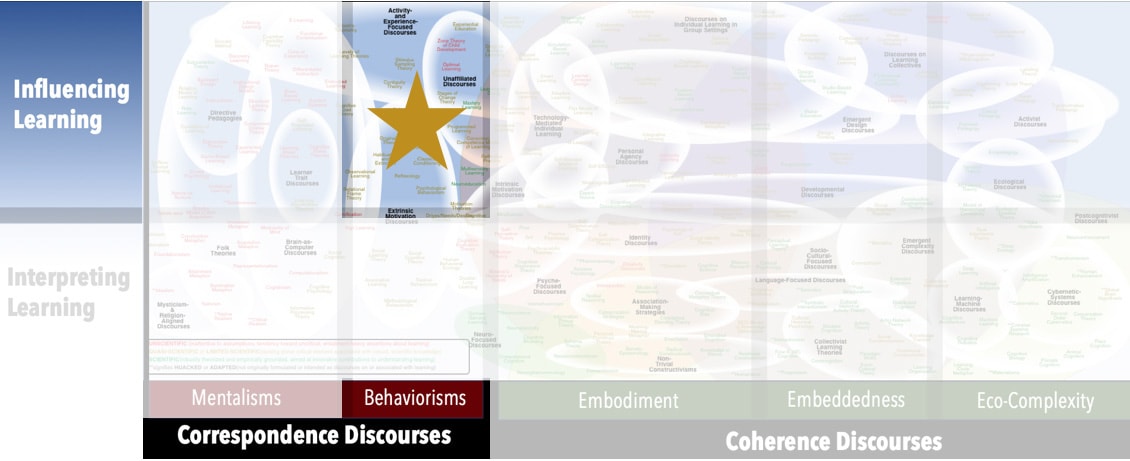AKA
Law of Contiguity
One-Trial Learning
Focus
Associating clusters of stimuli with specific movementsPrincipal Metaphors
- Knowledge is … all established patterns of activity
- Knowing is … replicating motions (triggered by a combination of stimuli)
- Learner is … a motion replicator
- Learning is … linking (a movement to a combination of stimuli)
- Teaching is … structuring experiences
Originated
1930sSynopsis
Like Behaviorisms, Contiguity Theory casts learning in terms of associations between stimuli and responses. Unlike Behaviorisms, Contiguity Theory focuses on the learning of movements (sensory-motor patterns) rather than behaviors, and it is founded on the assertion that movement that was accompanied by a "ice" – that is, aspecific combination of stimuli will likely happen again when that combination recurs. Learning is thus seen to happen in a single trial. In the context of schooling, Contiguity Theory focuses on replacing bad habits rather than punishing them. Techniques include:- Fatigue Method (Edwin Guthrie, 1930s) – After identifying the cue that triggers a bad habit, keep presenting that cue until the learner no longer responds with the habit.
- Incompatible Response Method (Edwin Guthrie, 1930s) – After identifying the cue that triggers a bad habit, whenever that cue occurs, compel the learner to engage in more acceptable activity that cannot coexist with the bad habit.
- Threshold Method (Edwin Guthrie, 1930s) – After identifying the cue that triggers a bad habit, expose the learner to that cue at a level too low to trigger the habit. Without ever exceeding the threshold that triggers the habit, gradually increase the intensity the cue over time, until the cue reaches its full strength.
- Association by Contiguity (Contiguity of Association) – the creation of a mental association between two aspects of experience because they occurred at the same time (or nearly the same time)
- Context Theory of Meaning (Edward Titchener, 1940s) – the assertion that the meaning of a perception, word, or concept depends on the mental image (and associated bodily sensations) that it triggers
- Recency Principle (Recency Effect) – the assertion that, when a fixed set of stimuli recurs, an organism will repeat whatever it did when it last encountered that set
Commentary
Contiguity Theory, while intended as a general theory of learning, was based mainly on research on animals and on personality disorders. Generalizations of its principles and advice are thus problematical. As well, if the theory is taken as correct, teaching humans becomes nearly impossible because (1) instruction must be very specific, since movements are dependent on particular clusters of conditions, and (2) human competencies typically involve a vast array of movements.Authors and/or Prominent Influences
Edwin GuthrieStatus as a Theory of Learning
Contiguity Theory is focused more on how to make learning happen (i.e., the conditions in which assumed or desired associations between stimuli and movements will happen), and so it’s more a theory of influencing learning than a theory of learning.Status as a Theory of Teaching
Contiguity Theory is a theory of structuring situations and experiences to change behavior – which pushes it into the category of theories of teaching. Much of its appeal arises in the fact that is focused more on replacing bad habits than punishing them.Status as a Scientific Theory
The evidence base for Contiguity Theory is narrow and shallow – entirely insufficient to make any strong assertions about human learning.Subdiscourses:
- Association by Contiguity (Contiguity of Association)
- Context Theory of Meaning
- Fatigue Method
- Incompatible Response Method
- Recency Principle (Recency Effect)
- Threshold Method
Map Location

Please cite this article as:
Davis, B., & Francis, K. (2023). “Contiguity Theory” in Discourses on Learning in Education. https://learningdiscourses.com.
⇦ Back to Map
⇦ Back to List
